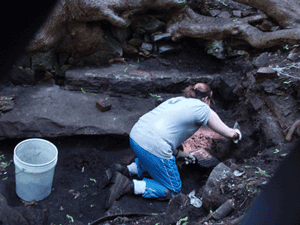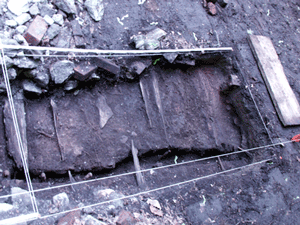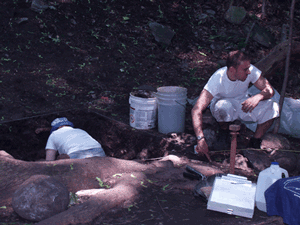2004
Field School in Industrial Archaeology - West Point Foundry
Michigan
Technological University
Posting June
11, 2004 by Scott See
As
an incoming student to the graduate program in Industrial Archaeology
at Michigan Tech, the field school environment has provided me with
an education on how "dirt" archaeology actually works
and offered an opportunity to put my own skills to the test in a
real-world environment.
The six weeks that I'm spending at the field school this summer is my first exposure to a working archaeological site and it really has been a fascinating educational experience. The site for the school, the West Point Foundry in Cold Spring, New York, offers a wide variety of opportunities for novice and experienced archaeologists. Although the site was in operation for almost a hundred years, it's also been abandoned for nearly 100 years. My first impression of the site was that it was surprising how little was left of the massive buildings that once produced huge numbers of iron goods for customers around the world. |
Stacey & Mike working in Blowing Engine area. |
| The piles of bricks, stones and other building materials provided teasing glimpses into what must have been an impressive operation to witness, but there was also obviously a lot missing. I also noticed that the shade of the trees and the sounds of the rushing water in the brook provided a park-like setting that could be very pleasing on a hot summer day. This combination of an important industrial history, limited physical evidence and a pleasing natural landscape seemed to be the perfect place to study industrial archaeology. The focus of the work this summer has been on the remains of the cannon boring mill and the blowing engine portion of the blast furnace operation. My initial assignment was to work with another student to excavate an area near the blast furnace where there appeared to be structural remains of the blowing engine. This machinery would have provided the blast of air necessary to raise the operating temperature of the furnace to a point where iron would melt out of the iron ore. |

Vanessa excavating in Blowing Engine (also Scott's excavation location) |
| My partner and I spent nearly three weeks carefully removing soil, rocks, stones and other debris in search of evidence. Along the way we uncovered a portion of an iron gear that could have been used on a waterwheel as well as several iron bands that are similar to those that would have been used to surround the blowing tubs that are central to how a blowing engine operates. In the boring mill, other students worked in a similar manner to uncover various structural components of the building as well as a number of hand tools and metal shaving waste from a lathe or boring operation. As I move into the remaining two weeks of my field school experience I found myself getting anxious to excavate additional areas and improve my archaeological skills. Luckily,
this week I was assigned to an area adjacent to a machine pad in
the boring mill. After only one day in this new area, it's clear
that I still have a lot to learn and that the variety of experiences
available at this site will be invaluable in helping me continue
to build my archaeological toolkit. Scott See |

Exposed floor of the Boring Mill. |
Email | Phone: (906) 487-2113 | Fax: (906) 487-2468
